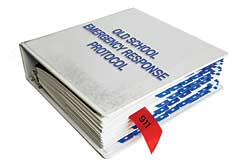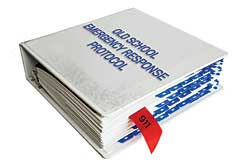
Ready and Waiting
More schools turning to database-driven, crisis management software solutions for emergency preparedness
 THICK, dusty, three-ring binders are no place to keep school
emergency response protocols. In the event of an emergency, information
and time is critical. Precious time can be lost in locating the binder,
flipping through the tabs to find the correct section and finally
finding the vital information. And what if an evacuation is necessary?
Lug the binder out and start the information search all over again
during different stages of the emergency? Even then, its contents are
only as good as the people who wrote the information, limited to how
much the binder can hold and only accessible to those on site.
THICK, dusty, three-ring binders are no place to keep school
emergency response protocols. In the event of an emergency, information
and time is critical. Precious time can be lost in locating the binder,
flipping through the tabs to find the correct section and finally
finding the vital information. And what if an evacuation is necessary?
Lug the binder out and start the information search all over again
during different stages of the emergency? Even then, its contents are
only as good as the people who wrote the information, limited to how
much the binder can hold and only accessible to those on site.
To a first responder, there's nothing worse than arriving to a site
and not knowing exactly where the emergency is and how to get to it.
Rapid Responder is designed to eliminate this scenario.
But in today's IT age, where information can be securely accessed
and disseminated in an instant, more schools are turning to advanced
measures such as database-driven, crisis management software solutions.
A Better Response
Seattle-based Prepared Response was founded to help prevent
tragedies like the one at Columbine High School in 1999. There were no
established protocols for the type of attack, and it forever changed
the concept of school security.
Prepared Response wants to use technology to better respond to
emergencies like Columbine. The company wants schools to engage in
state-of-the art pre-planning measures with school officials, police,
fire, state patrol and emergency services, and distribute the critical
information via a secure Internet connection, network or USB storage
device. Company officials believe that preparedness is part of a strong
defense.
To a first responder, there's nothing worse than arriving to a site
and not knowing exactly where the emergency is and how to get to it.
Rapid Responder is designed to eliminate this scenario.
"We usually implement the system a whole district at a time, which
includes working closely with local responders. We notify them that if
they get a 911 call at a specific address, that site has the Rapid
Responder system. We database everything you would want to know about a
critical infrastructure so when first responders arrive at the scene,
they don't have to go looking for information in order to make
decisions," said Jim Finnell, president and CEO of Rapid Response. "The
system is not meant to replace a 911 system, but when that call does
occur, within seconds, first responders can get right on the system and
have immediate access to everything they need to know."
"There's no limit to what kind of information can be entered," said
Walt Pegram, district resource officer for Spokane public schools.
With these systems, school officials and first responders can
instantly access more than 300 data points, including tactical
pre-plans, satellite and geospatial imagery, interior and exterior
photos, floor plans, staging areas, hazardous materials, utility
shut-offs, best access and evacuation routes, incident response plans,
and containment and family reunification locations. Try stuffing all
that in a binder.
In Action
On Sept. 22, 2003, Prepared Response accomplished what it set out
to do. A student pulled out a 9-millimeter handgun during science class
at Lewis and Clark High School in Spokane, Wash., shot at a cabinet and
demanded the teacher and students leave the room.
Fortunately, Rapid Responder was already in place. Within minutes of
the shot, the software was up and running in a command center,
providing site-specific information. Arriving officers were able to
isolate the gunman in less than 12 minutes while more than 2,000
students were quickly evacuated.
Officials using Rapid Responder noticed the room in which the gunman
was in had unobstructed views of a field where the students had
evacuated to along with eight lanes of traffic on an adjacent freeway.
Using contacts listed in the database, officials called a
transportation vendor to immediately send buses to relocate the
students offsite. A list of predetermined roadblocks from Rapid
Responder was sent to Spokane City Streets Department to block adjacent
streets and to Washington State Patrol to block access to the freeway.
During negotiations, the gunman asked for matches. Fire officials
knew from Rapid Responder that the student was in a science lab with a
number of natural gas outlets. Rapid Responder located the utility
shut-offs, and a crew from the local gas company shut off the gas.
Fire officials, concerned about possible hazardous chemicals, used
Rapid Responder to access a list of chemicals stored in the room. The
database listed the chemical types, location, quantity, MSDS profiling
of chemical characteristics and safety precautions.
The gunman acted aggressively towards the SWAT team and was wounded in the subsequent gunfire but survived.
The situation was defused in less than an hour, and no innocent
people were hurt thanks to the pre-planning measures and quick access
to crucial information.
"In addition to the active shooter scenario, the program also comes
in handy for everyday use. Two years ago, students grabbed a fire
suppression pipe and broke it. Hundreds of gallons of water began
spilling out on a brand-new parkay, hardwood floor in the gym. The head
custodian was out, and no one knew where shutoffs were. I pulled up
Rapid Responder and quickly accessed the fire suppression fire shutoff.
Having access to that information, the $150,000 gym floor was saved,"
Pegram said.
This article originally appeared in the February 2007 issue of Security Products, pg. 16.